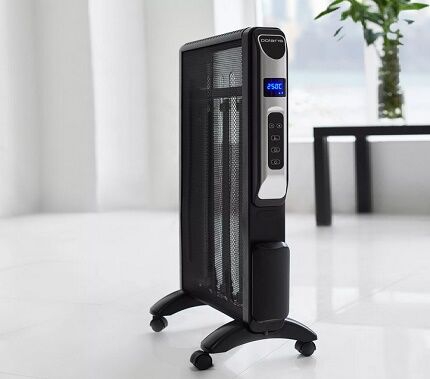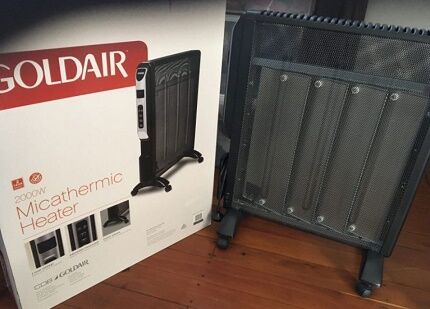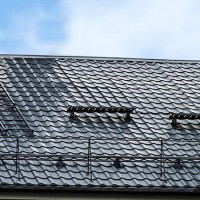Micathermic heaters: design, principle of operation, advantages and disadvantages
The problem of saving resources gradually affects all areas of human life. If you do not save heat and energy today, tomorrow you will have to face a shortage of natural reserves.Modern science is aimed at developing energy efficient "smart" devices, one of which is micathermic heater with infrared radiation.
You will learn everything about the design and operating principles of this innovative type of heating devices from the article we presented. We will talk about its varieties, their characteristic differences and selection rules. We will also analyze whether thermal infrared radiation is harmful or beneficial in everyday life.
The content of the article:
General information about micathermic heater
Micathermic A heater is an electrical device that emits infrared heat waves. IR heat is electromagnetic radiation that occupies the region of the spectrum between the red edge of light visible to the human eye (with a wavelength of λ = 0.74 μm) and microwave radiation (a wavelength of about 1-2 mm).
The heater has a multilayer design. Each of the layers of non-metals and metals included in it performs a strictly defined function. Some insulate, others concentrate and reflect heat waves. The principle of operation is extremely simple, and the device micathermic an infrared heater is quite understandable.
Design of a micathermic heating device
The development of the MK heater is based on achievements space technologies. However, in appearance it looks like regular convector.
The IR device consists of:
- heating element - a mica plate, with resistive flat elements or nitrochrome wire coils immersed in it;
- an insulator that prevents excessive heating of equipment (most often done using basalt);
- metal body of the device;
- a protective metal grille through which infrared radiation passes;
- stands for supports and rollers for moving.
To control and monitor operation, the heating device is equipped with:
- remote control;
- touch or push-button control panel;
- temperature controller;
- indicator board, which helps to understand the state of the unit;
- power regulator (most models of heaters that are on sale have a power of 1-2 kW).
The main working parts of MK heaters are micanite heaters. They are produced using technology Micathermik (Mikathermic). This technology consists of layer-by-layer application of mica onto metal heating elements.
The micanite heater is placed in a housing made of mica. It transports the thermal energy received from the heater to the room being treated. Infrared heat is directed to surrounding objects, and from them is transferred to the room being served. In this case, neither water nor oil coolants are used.
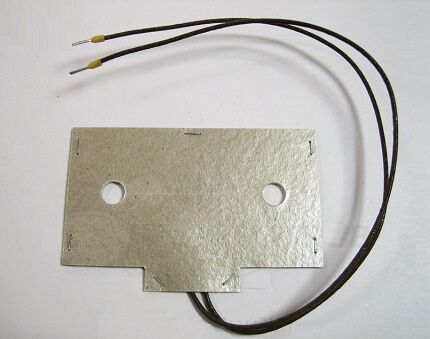
Micanite is paper pressed from tiny flakes of mica. This mineral, scaly in structure, is quite fragile, its layers are thinned to fractions of a millimeter.Mica has good electrical insulating, thermal conductivity and heat-resistant properties. It is often used in radioelements and capacitors.
The mineral is heated in an extremely short time, reaching 200 degrees or more. Due to the synthetic production of mica, the IR wavelength increases, while the intensity of the radiation decreases.
Mixing micanite with a heat-resistant binder and pressing them produces heat-resistant sheets with good dielectric properties that can be used in heaters. In addition, mica does not release toxic components when heated.
Mica layers insulate the heating element from the rest of the structure and transfer heat. The thickness of the mica plates is carefully selected depending on the overall dimensions of the device. Usually it is no more than 0.03-0.025 mm.
The thermal expansion of mica always coincides with the thermal expansion of the core. Thanks to this, maximum noiselessness during operation is achieved, because All kinds of clicks and knocks inside the device are eliminated.
Between the heating element and the mica plates there are 2 additional layers: inner and outer. The inner layer reflects heat, due to which infrared radiation is completely released into the space chosen for heating. The outer layer is responsible for increasing temperature flows.
The micanite heating element is placed in a metal case with mesh inserts. Infrared radiant heat passes freely through the perforated “shell”. The design is thought out in such a way that the thermal energy supplied by the device is distributed throughout the room with maximum uniformity.
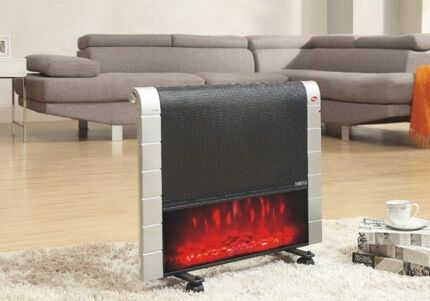
In addition to infrared thermal radiation, a noticeable flow of rising warm air propagates through the upper end of the grille (convection method) from a running MK heater, although the body of the device itself does not heat up.
During operation, the unit emits infrared and electromagnetic waves, which are in a range that is safe for living beings. Thereby micathermic heaters can be used in kindergartens or hospitals.
Operating principle of MK heater
Everyone's action micathermic The heater is based on heat transfer by infrared radiation (80% of the total performance) and the convection heating method due to the creation of air movement due to temperature differences (20%). By combining 2 heating techniques, the highest possible efficiency is achieved.
Those. it heats air volume and objects through infrared radiation from a distance. Thanks to this, heat transfer occurs much faster when compared with a water or oil radiator. After all, ordinary water, gas or electric convector heats only the air that comes into contact with its fins.
The MK heater transfers energy to the object with minimal dissipation. The role of an object can be objects, animals, or people. Moreover, after exposure to infrared waves, things and walls themselves become sources of heat and heat the air.
Outside the range of the IR heater, the room practically does not heat up.In this case, the heat flux density decreases with increasing distance between the heater and the object.
However, an IR heater is indispensable if you need to quickly heat up one item in the room. The body of the device itself, insulated with a composition using basalt, does not reach high temperatures (above 60 degrees), which eliminates the possibility of burns due to accidental contact with the unit.

But you cannot dry clothes on a heater, as there is a risk of fire. Some synthetic materials that come into contact with the device may melt or catch fire. The exception is special, improved models equipped with shelves for shoes or folding dryers for clean clothes.
Technically, the principle of operation of the elements micathermic The heater is quite simple. When the device is turned on, the plate begins to heat up. It heats up to 200-400 degrees Celsius and transfers heat to the mica layers.
The electrical energy imparted to the mica plates is transformed into infrared radiation directed at objects near the electrical appliance. This entire process takes a few minutes, and the room becomes warm almost immediately after turning on the equipment.
A small room (up to 20 sq.m.) can get hot micathermic device in 10 minutes. When the air in the room reaches the desired temperature, the thermostat in the unit is activated, turning off the heater. The equipment can be configured to automatically maintain a comfortable temperature background in the room.
High energy efficiency and efficiency are the main features micathermic heaters. They are characterized by high power, so they consume less electricity by about a third compared to conventional convectors. The efficiency of an infrared heater is about 90%.
Useful additional options
Standard MK heaters have a minimum number of settings, but some of them have various additional elements depending on the modification.
These elements include:
- built-in thermostats that allow you to control multiple air flows;
- liquid crystal displays with special protective functions;
- air ionizers and humidifiers;
- timers, etc.
Many micathermic The heaters have the function of protecting the room from freezing. If you activate this option and install the device in an unheated room, it will automatically turn on if the temperature in the room approaches zero.
Also, some heaters are equipped degree of protection IP24, which protects against moisture and prevents the possibility of device breakdown or short circuit if water gets on the equipment.

Classification by direction of radiation
All micathermic heaters are divided into:
- one-way devices, in which infrared rays are directed only in one direction;
- double-sided devices that radiate heat in both directions on the sides of the product;
- cylindrical units having a circular zone of infrared radiation.
Single-sided heaters can be wall-mounted or floor-mounted.They have a mesh front and back. The back side has small ventilation holes at the bottom.
Double-sided heaters are installed on the floor. They have two working plates that produce infrared rays. The heating plates are equipped with metal mesh. Single-sided and double-sided heaters direct infrared rays horizontally along the floor.
The horizontal supply of IR rays contributes to uneven distribution of heat in the room. With infrared radiation, the warmest air is closest to the floor, which helps keep your feet warm. Higher towards the ceiling it is usually colder.
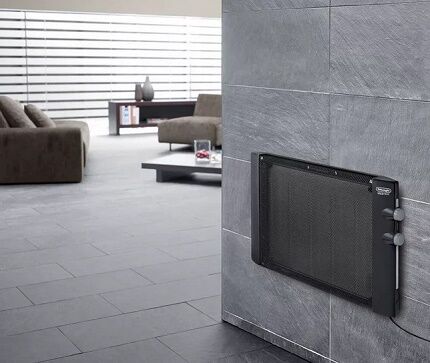
Cylindrical or oval-shaped heaters contain non-standard radiators (semi-circular or tubular). They can be attached to the ceiling or walls, depending on the features of the structure. Cylindrical heaters are distinguished by a circular zone of infrared radiation.
Common Use Cases
Infrared heaters can be used in indoor and outdoor areas. With their help you can heat a terrace, balcony, nursery or living room. Also, MK devices with the ability to heat by convection are appropriate to prevent the appearance of ice on the staircase.
Because when heating a room with infrared rays, there is no less oxygen in the air (and it does not dry out), IR devices are recommended for use in rooms where small children, asthmatics or allergy sufferers live.
But micathermic systems serve not only private owners, they are in demand in:
- medicine for the treatment of patients with blood flow disorders, cardiovascular pathologies, migraines and frequent acute respiratory infections;
- veterinary medicine for the treatment of animals;
- massage rooms (massage under infrared radiation helps reduce weight);
- offices to destroy viruses and bacteria.
By using micathermic heaters, you can create thermal curtains over panoramic windows and other translucent glass structures that have weak thermal insulation properties.
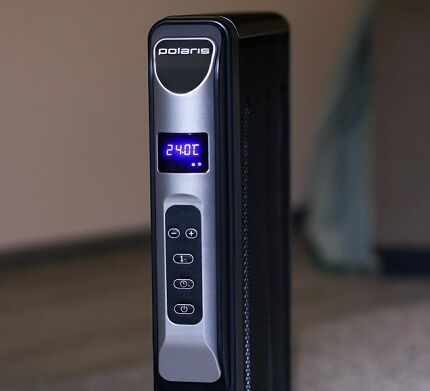
Advantages and disadvantages of micathermic heaters
Advantages and disadvantages micathermic heaters are determined by the operating principle and design of the equipment.
The device has an impressive number of advantages, which include:
- energy efficiency;
- high heating speed;
- compact body;
- stylish appearance;
- light weight (depending on the type of unit varies in the range of 3-4 kg);
- safety;
- maintaining a healthy indoor microclimate;
- minimal background noise during operation, etc.
Also micathermic The heater prevents the development of microbial and viral microflora, and also kills fungus in the room. However, this device does not have a bactericidal effect and cannot be used along with ultraviolet lamps For quartzization.
During operation of the infrared device, no accumulation of air mass is formed under the ceiling.Thanks to this, IR equipment is perfect for rooms with high ceilings, because... heat will not dissipate over the entire area. But through the holes in the casing of the unit a lot of dust gets in, which is almost impossible to get out of there.
When you turn on the device, dust and dirt become hot and smell bad. The smell will disappear only when the dust burns completely. It's remarkable what the stench is micathermic The heating device will emit heat whenever it is left turned off for a long time.
How to choose the right model?
At the time of buying micathermic The design of the heater must be based on the characteristics of the room in which it will be placed. Approximately for every 10 sq.m. housing you need to take 1 kW of power without taking into account heat loss.
If this will be the only heat source, you need to choose a device with more power. If you buy an infrared heater for a small summer house, you can choose a device with a power of no more than 70 W per 1 sq.m.
In reality, heat the room with only one micathermic the heater is difficult, because you need to think very carefully about the location of the device. Maximum heating of air and objects will be observed only at a distance of a couple of meters from the front panel.
Before purchasing an MK heater you need to ask the seller for all the necessary supporting documentation, incl. hygienic certificate for the isolator. It is better to buy equipment with a basalt insulator, which can be used even in the food industry (marks about this are usually present in the hygiene certificate).
Any electrical equipment needs timely and complete care. Due to the structure micathermic Heaters should be regularly vacuumed and wiped with a damp cloth to remove accumulated dust. Before cleaning the device, turn off the power.
Is infrared waves harmful to the body a myth?
Infrared waves are traditional electromagnetic radiation, similar in structure to solar rays. Harm and benefits of infrared radiation determined by the depth of penetration of these waves into the skin.
There are 3 types of heating devices depending on the wavelength and incandescent temperature of the heating element:
- devices with maximum heating up to 300 degrees and wavelength 50-200 microns;
- devices heating up to 600 degrees and with a wavelength of 2.5-50 microns;
- heaters with heating up to 800 degrees and a wavelength of 0.7-2.5 microns.
Those. The higher the filament temperature of the device, the more short waves will be emitted. For an ordinary healthy person, heat waves with a length of about 9.6 microns are safe. Manufacturers indicate the range of infrared radiation in the technical device data sheet.
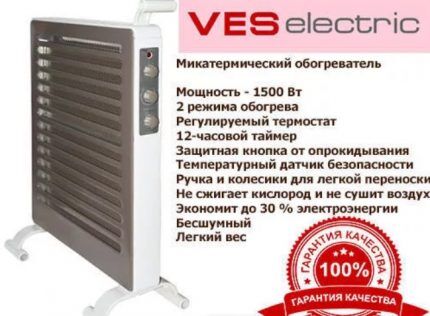
Typically it varies between 2-10 microns. In this case, the intensity of IR radiation depends on the characteristics of the heated surface (especially its emissivity). The most powerful radiation comes from a heated black object.
Any prolonged targeted infrared radiation has a bad effect on the human body, which is expressed in:
- drying out of the skin;
- decreased vision (long-term exposure increases the risk of developing cataracts);
- disruption of the structure of cell membranes (typical of short infrared waves), etc.
It is especially dangerous to install a powerful ceiling heater in a room with low ceilings. In this case, infrared rays will constantly heat a person’s head and can lead to the development of all kinds of diseases.
But the real harm is these infrared heaters can be brought only in the case of a constant directed flow towards a person. Ideally, the devices should be installed so that the heaters give off their heat to walls or pieces of furniture, but are not directed at a person.
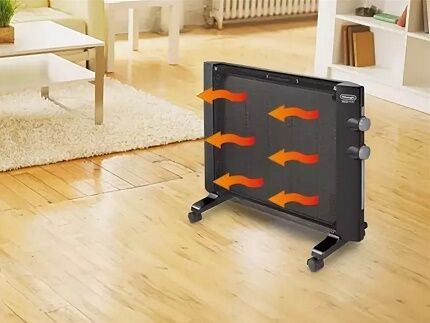
However, in Japan and Europe, entire institutes are developing methods to combat cancer based on the influence of infrared radiation. In the course of scientific research, it has been proven that infrared waves, reaching 14-20 cm inside the skin, carry out effective detoxification cells.
This occurs due to selective hyperthermia, increasing biochemical circulation and eliminating congestion in tissues. The result of using radiation depends on correctly selected schemes, and micathermic The heater is absolutely safe for health if you use common sense when installing it.
Conclusions and useful video on the topic
The video provides an overview of the MK-1501 micathermic heater - innovative equipment, using an example of which you can understand the principle of operation of infrared heaters:
A micathermic heater is an innovative electrical device that is used for heating rooms. Its functioning is based on infrared radiation from micanite elements.The equipment is characterized by high inefficiency, energy efficiency, compactness and versatility.
Would you like to share your own experience in choosing an infrared heater? Do you have useful information on the topic of the article? Please write comments in the block below, post photos, and ask questions.
